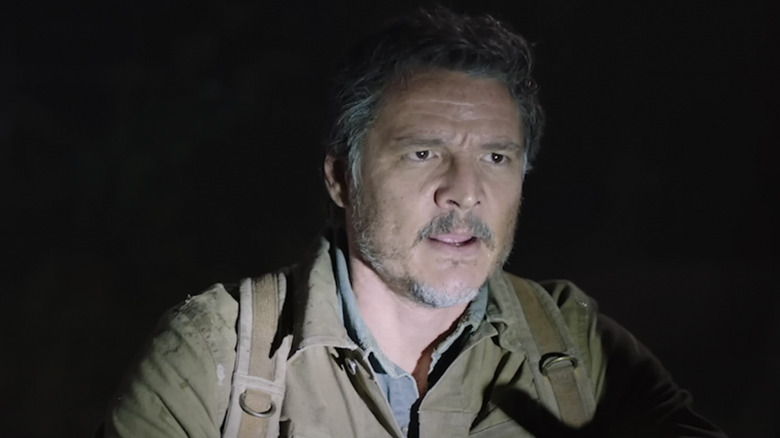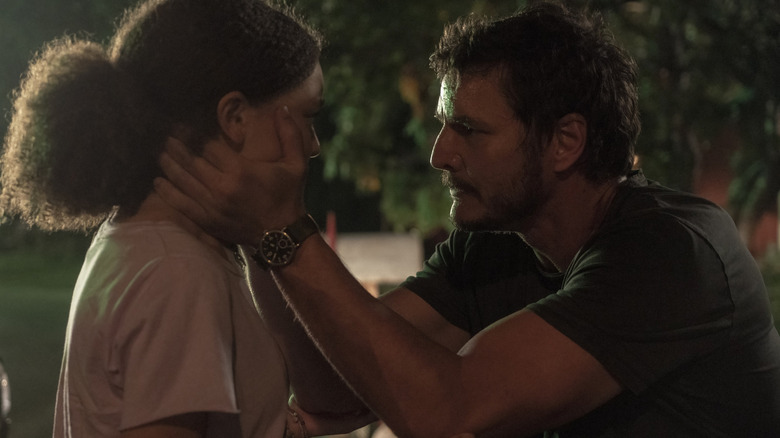A Key Death Hits Way Harder In HBO's The Last Of Us
This post contains spoilers for the first episode of "The Last of Us."
HBO's "The Last of Us" adaptation is finally here, and it's exactly what fans of the franchise were hoping for. Featuring a largely game-accurate plot and an appropriately dark tone, showrunners Craig Mazin and Neil Druckmann have cracked the code on what a video game adaptation should look and feel like. Based on the pilot alone, the series looks to improve upon several key aspects of the source material, too. Sarah's death, in particular, hits far harder in the live-action adaptation than it does in the original video game.
The post-apocalyptic world that the characters inhabit in "The Last of Us" often comes second to the relationships they form with each other. The first episode of the HBO series reinforces this idea by introducing more scenes between Joel (Pedro Pascal) and Sarah (Nico Parker) before her death at the start of the cordyceps fungus outbreak. In fact, a good chunk of the one hour and twenty-minute runtime is made up entirely of new development for the central characters. The expanded efforts result in a far more emotionally devastating sequence, in which Sarah still meets an identical fate to her video game counterpart.
Getting to know Sarah
After the brilliant title sequence plays, "The Last of Us" once again opts to present outbreak day through Sarah's point of view, this time several hours before the zombies attacked her home. From the get-go, we see Sarah interact with Joel and Tommy (Gabriel Luna) throughout her father's birthday. Their dynamic is fleshed out and believable; the chemistry is palpable between the actors. Then, Sarah gets to venture out into town to fix a gift for Joel, and we witness the anxiety-inducing moments of townspeople slowly discovering that something very wrong is about to happen. There is even a minor subplot featuring an elderly neighbor, the first of many infected Joel will encounter throughout the story.
Although there are small deviations, the extra material feels like a natural precursor to the events that unfold early in the original story. Moreover, it emphasizes the world-building aspect "The Last of Us" is known for without feeling optional. In the video game, players have to figure out the details of Sarah and Joel's relationship for themselves by exploring the house and looking for context clues. It works well in that medium, but translating that to screen in a literal fashion would have diminished the potential of the adaptation. Sarah's final scene not only recaptures the details of the video game, but also uniquely benefits from the extended screen time.
A death in the family
Let's be clear: Troy Baker and Hana Hayes are amazing as Joel and Sarah, respectively, in the death scene from the original "The Last of Us." Both display an incredible amount of vulnerability in what was the last time Joel felt tethered to his moral compass. In HBO's live-action adaptation, Pascal and Parker are able to replicate the emotional factor and the sequence is faithfully recreated for a reason. They can't one-up perfection in a singular instance, but expanding on it is a worthwhile endeavor that pays off in the series.
When Joel holds Sarah in his arms during her final breaths, the tragic loss is accentuated by the time we spent with her. We understand more deeply than ever the shared bond they had long before Ellie (Bella Ramsey) arrived in his life. When the show jumps ahead to 2023, the air of despair that floats around Joel has more emotional significance. And despite the departure from the source material, "The Last of Us" will seemingly cover everything from the first video game in the nine-episode season. If the pilot is anything to go by, the tears will continue to stream for episodes to come.
New episodes of "The Last of Us" air on Sundays on HBO and HBO Max.


